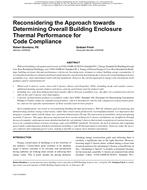Description
With each building code update and revision of ANSI/ASHRAE/IESNA Standard 90.1, Energy Standard for Buildings Except Low-Rise Residential Buildings, and ANSI/ASHRAE Standard 90.2, Energy-Efficient Design of Low-Rise Residential Buildings, building enclosure thermal performance criteria are becoming more stringent to reduce building energy consumption. It is well understood that two-dimensional heat transfer must be considered in determining the U-factor of certain building enclosure assemblies (e.g., steel-stud-framed walls with batt insulation). However, the current approach to energy code calculations lacks guidance and/or requirements for
- Whole-wall U-factors versus clear-wall U-factors (Kosny and Desjarlais 1994), including inside and outside corners, additional framing around windows and doors, and top and bottom track for framed walls
- Including two- and three-dimensional heat transfer effects between assemblies (e.g., the effect of a cantilevered concrete slab on the wall U-factor, steel shelf angles)
- U-factors of fenestration products as installed, rather than NFRC Standard 100, Procedure for Determining Fenestration Product U-Factor, values for standard-sized products, which is intended for side-by-side comparison of fenestration product, and are not typically representative of those actually used on most projects
Such simplifications can result in overestimating building thermal performance. With the ultimate goal of analyzing and demonstrating realistic energy conservation, rather than conservation predicted by oversimplified models, it is imperative that designers consider whole-wall R-values, two- and three-dimensional (2D and 3D) interaction of assemblies, and actual glazing assembly U-factors. This paper discusses and presents how current methods for U-factor calculations are insufficient through the use of examples, and proposes more detailed methods for calculating U-factors that include recognition of construction practices to be considered future revisions of energy codes and ASHRAE standards. Previously, the lack of software and computing power made conducting more detailed calculations including 2- and 3D thermal analysis unrealistic. However, today the necessary software and computing power exists, making it feasible to require more detailed calculations.
Citation: Thermal Performance, International Conference, 2010
Product Details
- Published:
- 2010
- Number of Pages:
- 10
- File Size:
- 1 file , 4 MB
- Product Code(s):
- D-BUILDINGSXI-137




